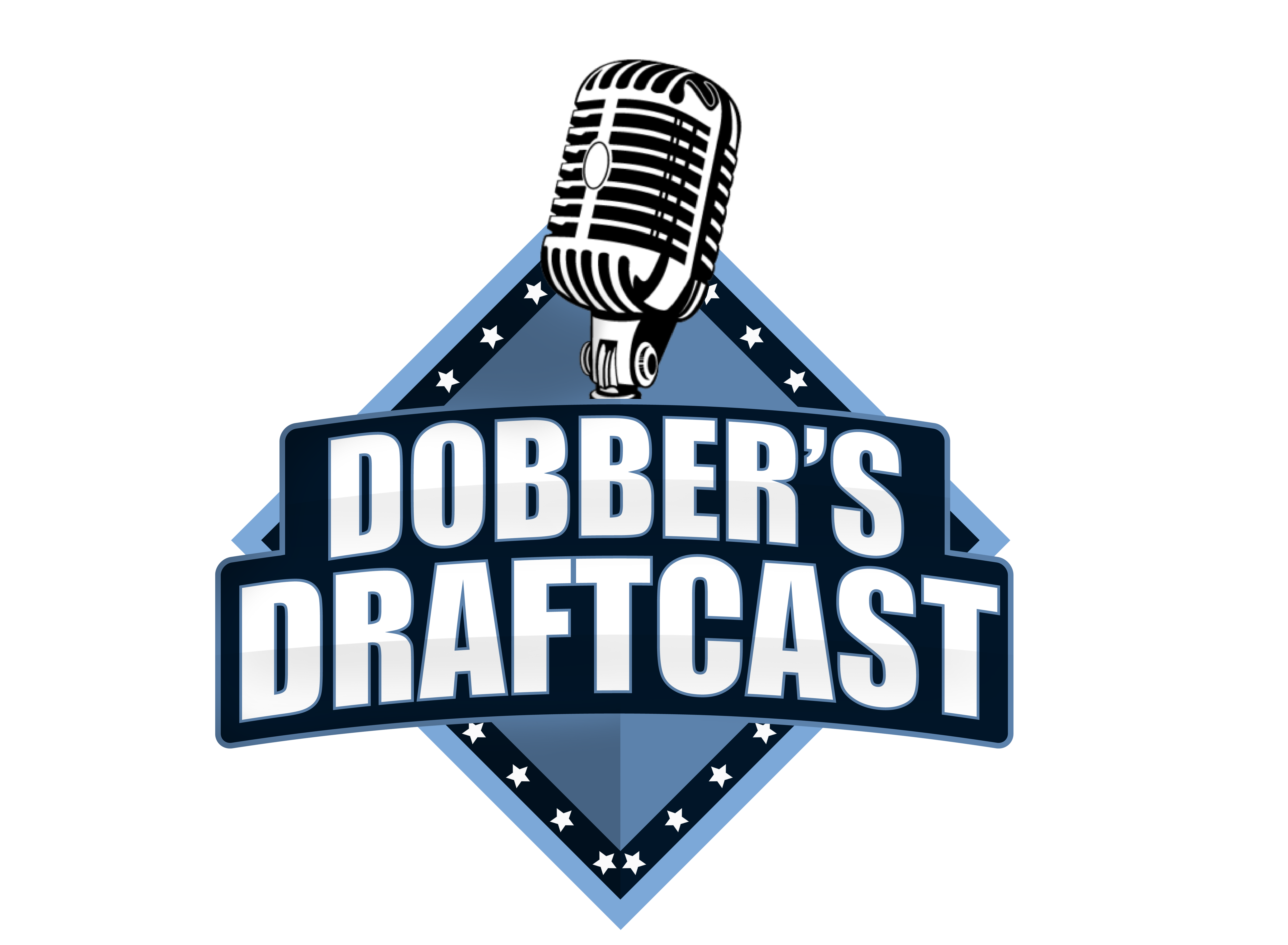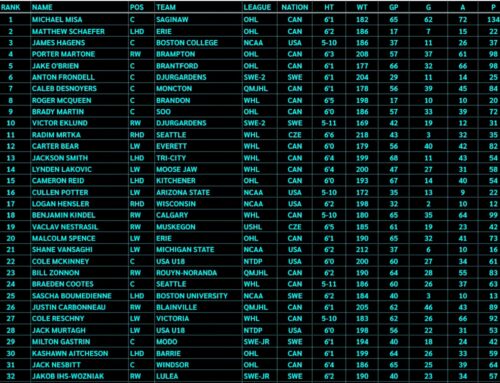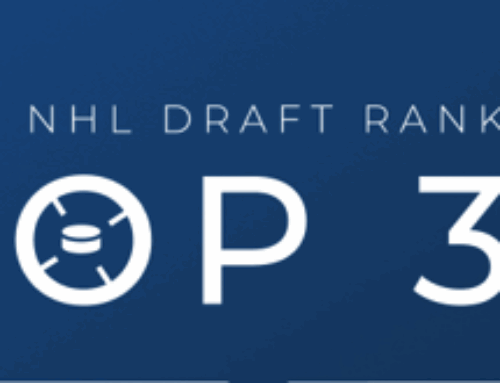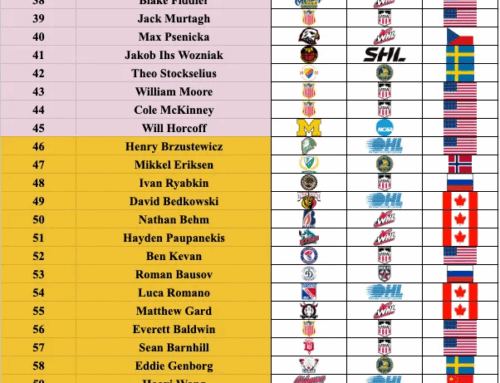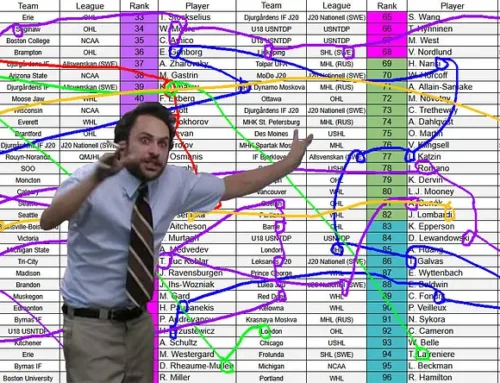NCAA Update: February
JP Gambatese
2025-02-17
The 34-game NCAA season is rapidly coming to a close, with several teams crossing the 30-game threshold already. With that in mind, it is important to look at how each team’s college prospects are doing, considering that their sample size for this season is large. The NCAA is an excellent development league for many systems’ top prospects, and the Eastern Conference, in particular, is chock-full of high-level collegiate talent.
Disclaimer: All listed statistics are as of Monday, February 10 afternoon.
Metropolitan Division
Carolina Hurricanes – Jayden Perron (RW)
Life is tough when you’re 5-9 and are not a high-end skater, but Perron has done well enough in his first two seasons of college hockey to warrant a spot here. He is a highly cerebral player, relying on understanding the course of play before it has even developed. Without the puck, he can find space by baiting defenders into moving in one direction while sneaking off in another. With the puck, he draws attention from stick multiple defenders to allow space for his teammates and has a zippy, accurate pass to find them. He has relatively soft hands and an above-average wrist shot. The problems lie predominantly in his size – without otherworldly skating abilities, he will struggle to keep defensemen at bay at times and is generally outpowered by others on the ice. Still, his IQ may result in an NHL appearance after a couple more years of marination at the University of North Dakota. He should produce at a higher level as he gains more weight and strength over the next two years.
26 Games Played: 9 G | 8 A | 17 TP | 2 PIM | 65 SOG | 13.8 SH%
Columbus Blue Jackets – William Whitelaw (C)
Whitelaw has not taken a gigantic step forward like some anticipated in his second year in the NCAA – this season playing for a bigger powerhouse in the University of Michigan – but there is still a ton to like about his game. He has maintained his strengths as an offensive do-it-all but has taken a small step forward regarding defensive responsibility. That can probably be attributed to understanding that, at 5-9, he will need to put in that much more effort to make an impact, which has trickled into his defensive game. His point production (nine goals, 14 total points in 29 games) is mildly impressive, considering that he has spent much of the season playing on the wing on the fourth line, and it’s entirely due to his offensive toolkit that has no fundamental weaknesses. He is blisteringly fast and has the edges one would expect from such a minor player. His shot is his best asset, beating goaltenders at a distance with a deceptive release and pinpoint accuracy. There is no shot type that Whitelaw lacks aptitude at. His passing is crisp and confident, and he understands that he doesn’t need to shoot all the time despite his high-end shot. He will likely find himself in a more prominent role with Michigan next season, so it’ll be exciting to see if his point production matches the eye-test capabilities.
29 Games Played: 9 G | 5 A | 14 TP | 26 PIM | 81 SOG | 11.1 SH%
New Jersey Devils – Mikhail Yegorov (G)
This is a bit of a cop-out pick, considering Yegorov was recently brought over to the NCAA after a deceivingly strong start to his USHL campaign on a weak Omaha Lancers team. I say deceivingly because his 3.12 goals-against average (GAA) and 3-12-3 record don’t jump off the page as “successful.” Still, his .912 save percentage (SV%) is undoubtedly impressive and is a testament to the team in front of him, leaking scoring chance after scoring chance. With that in mind, this was a smart move from Boston University, which has gotten subpar performances from Mathieu Caron and Max Lacroix all season long. His 6-5 frame is more than NHL size, and he uses it well. He rarely overthinks plays that quickly develop, making him an asset on high-danger opportunities, and he has excellent reaction and puck-tracking instincts. Yegorov has already impressed and should push for the most playing time on the team as far as goaltenders go, having touted a .940 SV% and GAA of 1.51 thus far into his collegiate career. He should continue to thrive in an NCAA setting under ex-Devil Jay Pandolfo as head coach for at least a couple more years before potentially jumping to the big leagues.
4 Games Played: 2-2-0 | .940 SV% | 1.51 GAA | 0 SO
Honorable Mention: Artem Shlaine (C) – Just because Yegorov was a recent inductee into the NCAA level, I figured I should include the Devils’ best college prospect outside of him: Artem Shlaine. Shlaine has missed some time due to injury – including a recent stretch that began with seeing the 22-year-old stretchered off the ice, but when healthy, he has been one of the top producers on a per-game basis in all of college hockey. His 1.27 points per game rank 9th in the entire NCAA. His puck skills, already his best asset, have improved this season. He has a wide array of dekes that he can use at his admittedly unimpressive full speed. On top of that, he has displayed real defensive responsibility, leading Arizona State in time on ice among forwards and being a top faceoff-taking center in the league. For a team that significantly lacks center talent, Shlaine stands out as a could-be bottom-sixer, though he is a college free agent and may move organizations.
22 Games Played: 10G / 18 A / 28 TP / 0 PIM / 44 SOG / 22.7 SH%
New York Islanders – Cole Eiserman (LW):
Once considered the unanimous second-overall option behind Macklin Celebrini, Eiserman slid down to 20th overall in the 2024 NHL Entry Draft because scouts were concerned about his one-dimensional play. While that is true to an extent, his one dimension is otherworldly, and he has taken strides in other facets of his game. His shot was undoubtedly the best in his draft class, and if he were to be placed in the NHL right now, I’m not sure there are 10 players in the league with better shooting mechanics than him. His release is deceptive; he can accurately pick any mark on the net and beat any goaltender from any range under any circumstance. Goaltenders must always be on high alert when he’s on the ice. His hamartia has always been that there is a level of laziness in his game, though I do have to say that it has improved this season. He can still be caught waiting for the pass from his teammates, but he has been more active in forechecking to regain possession of the puck. Despite his lackluster box score (one in which he has still been near-point-per-game), he has shown off more of his underrated playmaking side, even if he’ll often look off an open teammate in favor of shooting the puck on the net. There’s a definite top-six, first power play unit upside, and he could push for 40 goals a season in the NHL.
25 Games Played: 15 G | 8 A | 23 TP | 27 PIM | 63 SOG | 23.8 SH%
Honorable Mention – Quinn Finley (LW): The season Finley is having is quite frankly remarkable, and he finds himself right at the top of the running for the Hobey Baker Award because of it. He has produced 34 points in just 30 games and has fully evolved his game this season. He shoots all the time, and for good reason. He is a threat from all distances, with all shot types. His playmaking and skating could use some work, but if his role as an NHLer is a scoring passenger winger, they won’t need to improve much more.
30 Games Played: 19 G / 15 A / 34 TP / 16 PIM / 111 SOG / 17.1 SH%
New York Rangers – Gabe Perreault (RW)
Perreault has quickly become arguably the league’s best prospect despite draft-year concerns about his skating. He is undeniably intelligent with and without the puck and has soft, quick hands. He is aware of everything happening on the ice, which is a rarity among NHLers, let alone 19-year-olds. He boasts otherworldly consciousness of what defenders he draws in, what teammates he leaves open, and who his best target for a pass is. I’m not sold on his ability to score goals at a crazy-high clip, though his shot isn’t a detriment to the rest of his game. Perreault’s skating has taken strides (pun intended), and he’s more than capable of beating defenders one-on-one with solid speed, strength, and a wide array of dekes and dangles. There has been a bit of a dip in production this season as compared to the 60-point campaign he put out last season with the Eagles, with 35 points in 26 games, but he is still a part of the top line in college hockey, leads them in points, and is the driving force behind why they’re so successful. I’m not sure there is a prospect in any system with playmaking chops as strong as Perreault, so I would be shocked if he did not turn into a top-line, point-per-game winger at the NHL level at minimum.
26 Games Played: 10 G | 25 A | 35 TP | 6 PIM | 75 SOG | 13.3 SH%
Philadelphia Flyers – Alex Bump (LW)
Bump produced at a near point-per-game pace last season with Western Michigan University, and he has elevated his game to slightly above in his sophomore season. He doesn’t do anything particularly remarkably, but his release is solid and he has NHL size. He often gets himself in good positions to score and has pinpoint accuracy that works at short-to-mid distances. He is not a great skater, with short strides that don’t generate as much power as one would like to see from a 6-2 200-ish-pound forward. His edgework is unremarkable, and his top speed is below average. Bump is hard to knock off the puck, though, which he sometimes uses to his advantage to create space for his teammates. He will need to improve his skating to make an impression in training camps, but there is a path to the NHL as a bottom-six winger with a scoring touch if he can make some progress there.
26 Games Played: 12 G | 18 A | 30 TP | 6 PIM | 139 SOG | 8.6 SH%
Honorable Mention: Cole Knuble (C) – Knuble has had a strong season as Notre Dame’s leading scorer (28 points in 24 games). Like Bump, he has nothing special in his kit – except one thing: work ethic. He’s a tenacious worker, making money on the forecheck and never giving up on plays. He contributes on both sides of the ice and in transition, and most of his points come from drawing in defenders with that tenacity. He could find a spot as an energy-filled fourth-liner, but that’s probably his ceiling in the NHL.
24 Games Played: 9 G / 19 A / 28 TP / 10 PIM / 84 SOG / 10.7 SH%
Pittsburgh Penguins – Cruz Lucius (RW)
Lucius has appeared in very few games this season with Arizona State – he missed months with an injury but has projectable skills as a would-be passenger winger. He is a cerebral player, slowing the game down, drawing defenders in, and capitalizing on their lack of patience. He can read plays exceptionally well and adapt accordingly, and he has a solid shot to boot when defenders don’t bite. Lucius’s worst attribute, part of his game that will hold him back in the NHL, is his skating. He often skates with two hands on his stick, stifling his power generation. Lucius has decent enough edges, but his top speed lacks and his acceleration to that top speed is substandard. He has the brains and playmaking ability to make it in a middle-six capacity if he irons out that skating a bit, but if not, he is likely looking at a career in the AHL.
10 Games Played: 2 G | 5 A | 7 TP | 6 PIM | 22 SOG | 9.1 SH%
Washington Capitals – Ryan Leonard (C)
Leonard is the quintessential Washington prospect – gritty while maintaining high skill levels. His hands are his best asset, having lightning-quick puck movement and a wide array of dekes that he can pull out creatively at any time. Past that, he’s extraordinarily reliant on his physical edge; he makes a point to shove off defenders with the puck on his stick, beelining it to the interior slot at every chance he gets, especially if that means he can plow over a defender in stride. Leonard is scrappy, tenacious and nonstop. This sometimes means he gets carried away, as he has had some discipline issues when things get heated. Still, his offensive instincts are top-notch, and even if he has brain lapses in playmaking and off-puck positioning, he has the raw tools and physical dominance to make it in a top-six role at the NHL level. Leonard has been one of the NCAA’s most productive forwards in the past two seasons, and in this season in particular, he’s scoring at a near-goal-per-game rate. I’m not sure he has point-per-game chops in the big leagues, but he could turn into a 35-goal power forward.
26 Games Played: 23 G | 11 A | 34 TP | 24 PIM | 134 SOG | 17.2 SH%
Honorable Mention: Cole Hutson (LHD) – Undoubtedly, the title of “best NCAA prospect” for the Capitals should be Leonard, but I would be remiss if I didn’t touch on Hutson’s performances this season. On top of the point-per-game pace he’s cruising at with Boston University, he dominated at the World Junior Championship, posting the most points of any player in the tournament with 11 in seven games. Like his brother Lane, he is active on the blue line, able to shimmy and easily shake his way off of pressuring forwards. He is an expert in maintaining puck possession and passing in the zone. With a bit of added heft to his small 5-10 frame, he will be even more challenging to bully off the puck. He should turn into a second-pairing offensive defenseman with power play upside.
25 Games Played: 7 G / 20 A / 27 TP / 48 PIM / 68 SOG / 10.3 SH%
Atlantic Division
Boston Bruins – Dean Letourneau (C)
I’ll be the first to admit that Letourneau’s statistical profile is abysmal relative to some collegiate prospects in the Bruins’ system. He has put up only two points (only assists) in 26 games with Boston College, but it is worth noting that he was a known project when he was drafted. Letourneau is a giant (6-7, 214 pounds) but doesn’t move or play like it. He does not have a lengthy, slow stride – instead, he uses crossovers to generate power. He has decent hands and solid in-tight abilities, which are particularly impressive given his gigantic frame. Letourneau would be better off relying more on his size to bully the enemy off the puck more. There is exactly one player in the NHL whose size doesn’t rely mainly on physicality to get the job done, and Letourneau’s skill level is nowhere near Tage Thompson’s. Eventually, there should be a bottom-six center here, but I’m not sure he will be anything more than that without changing how he plays.
25 Games Played: 0 G | 2 A | 2 TP | 4 PIM | 26 SOG | 0.0 SH%
Buffalo Sabres – Brodie Ziemer (RW)
Ziemer does everything the right way. He’s defensively responsible, has no notable weak spots in his game, and is a natural-born leader. Despite possessing no weaknesses, Ziemer also does not have a particular strength to his game. His shot is average, his playmaking is average, and his hockey sense is average. I don’t notice a particularly high or low competitive level in Ziemer’s game when he plays, but he always seems to be in the right spot at the right time and doesn’t shy away from getting into the dirty areas of the ice. There are legitimate concerns that his lack of a high-end anything will prevent him from making the jump. Still, I can certainly see him carving a role as a third-line glue guy if things progress well – it is important to note that, despite the evident maturity of his game, he is only a teenager.
28 Games Played: 11 G | 8 A | 19 TP | 21 PIM | 65 SOG | 16.9 SH%
Honorable Mention: Maxim Štrbák (RHD) – Strbak is a Ziemer-esque defenseman who plays the right way and is committed to a mature game. His skating was touted as high-end at the time of his selection, but I’ve seen more ups and downs than I’d like from a player. His top speed is solid, but it takes a bit longer for him to get there, and his edgework isn’t as fluid as one would expect from a 6-2 skater. However, he knows when and how to use his body to seal off an attacking forward and when it’s better to use an active stick to push the play to the outside. I’m not sure there’s much of an offensive ceiling there, though he has put up more points in a more expanded role with Michigan State this season. He occasionally shows flashes of a strong first pass, but it’s far too inconsistent for me to project him as anything but a third-pair, defensive complement.
26 Games Played: 1 G / 14 A / 15 TP / 16 PIM / 42 SOG / 2.4 SH%
Detroit Red Wings – Trey Augustine (G)
The Red Wings have a two-headed monster between Augustine and Sebastian Cossa in their goalie pipeline. He’s undersized for a current NHL goaltender at 6-1, but he is as composed as any goalie you will ever watch. He rarely gets frazzled and is more content sitting back in his crease and letting the play come to him than becoming aggressive and having to recover. Augustine is particularly strong when seeing pucks through screens and hugging the posts when called upon. He isn’t as athletic as perhaps you’d like to see from a smaller goalie, but he is more controlled than most and can keep play to the outside rather than allowing rebounds to hit the center of the ice for another grade-A chance against.
23 Games Played: 15-5-3 | .926 SV% | 2.07 GAA | 2 SO
Honorable Mention: Max Plante (LW) – Plante is an excellent playmaker and a hard worker, but some concerns may limit his ceiling as an NHLer, predominantly his skating. His top speed is below average, his acceleration is subpar, and his edgework is ordinary for a player under six feet tall. His shot, while not a detriment to his game, isn’t a huge threat, but his passing work and hockey sense make up for it. Plante often finds himself in the right place at the right time and has an outstanding balance of understanding of the game and the ability to get into open space. I could see him becoming an offensively oriented third-line complementary winger in the big leagues, but I don’t think his skating ability allows for much more growth than that.
13 Games Played: 6 G / 10 A / 16 TP / 4 PIM / 46 SOG / 13.0 SH%
Florida Panthers – Jack Devine (RW)
Devine slid quite a bit from his draft projection in 2022, getting drafted 221st overall despite rankings solidifying him as a top-120 selection. Now, he looks like the Panthers’ best prospect by proxy of his production in the NCAA over the last two seasons. He’s taken a goal-scoring backseat to linemate Sam Harris, which has stymied his goal totals after scoring the fourth-most in college last season (27), but with that, he has been able to showcase his playmaking aptitude as well. Since Devine was a draft-eligible prospect, it was apparent that his incessant motor skills were of the best quality. He best uses it in-zone, tenaciously forechecking to create opportunities for himself and, this season, in particular, his teammates. I wish Devine showed off his shot a bit more, as it is a true weapon for him that could open up even more possibilities from a passing standpoint, but it is admittedly hard to argue with the results he’s generating. His 33 assists rank first across the entire NCAA. Devine is yet again producing at an above-point-per-game rate and profiles as a middle-six passenger player who will do well with a center who can transition the puck from the defensive to offensive zones.
28 Games Played: 6 G | 33 A | 39 TP | 10 PIM | 93 SOG | 6.5 SH%
Montreal Canadiens – Jacob Fowler (G)
Fowler has made a name for himself as perhaps the top goaltending prospect in the league. He, too, was nominated for the Hobey Baker Award and has the highest SV% of any under-21 goalie with at least 20 games played since Thatcher Demko’s 2015-16 season. At 6-2, he possesses superhuman athleticism, which will only be exacerbated when he loses a bit of weight, allowing him to move even better laterally. Fowler quickly drops into a butterfly, shutting the door on five-hole opportunities exceptionally well. His hands are otherworldly, his reflexes are phenomenal, and he tracks shots like few in the league do. Fowler has the making of a star goaltender.
24 Games Played: 19-3-1 / .936 SV% / 1.66 GAA / 6 SO
Honorable Mention: Michael Hage (C) – Hage is a highly skilled center who can skate well. He seemingly slows time on the rush and can beat goaltenders with his shot and playmaking ability in odd-man situations. For a 6-1 sub-200-pound player, Hage is extremely strong on the puck, using power moves to get around defenders easily while generating space for himself and his teammates. He is undoubtedly a rare breed, especially as an 18-year-old, and should contribute to the Canadiens’ top six soon.
27 Games Played: 12 G | 18 A | 30 TP | 21 PIM | 63 SOG | 19.0 SH%
Ottawa Senators – Hoyt Stanley (RHD)
Nothing is as important to see in a defenseman as mobility, and Stanley has plenty of it for a defenseman his size at 6-3. He has immaculate edgework; his ability to easily generate side-to-side power and explode in one direction makes him an asset at bringing the puck out of his zone after retrieving it. Stanley’s hockey sense is inconsistent – he sometimes makes an unnecessarily dangerous pass that can get intercepted and lead to a scoring chance against. When well-thought-out, his first pass can be electric and accurate, but when paired with his excellent mobility it makes him a diamond in the rough in terms of transitional north-south play. Stanley’s shot is unremarkable, but that is something that he can focus on in the next couple of seasons because his skating is so great. He profiles as a puck-moving third-pair defenseman who will not put up many points but will contribute at both ends of the ice well enough.
23 Games Played: 1 G | 5 A | 6 TP | 31 PIM | 20 SOG | 5.0 SH%
Honorable Mention: Kevin Reidler (G) – He has only played in six games. Still, Reidler has been impressive in starting his NCAA career with the University of Nebraska-Omaha, posting an SV% of .913 and a GAA of 2.79. His massive 6-6 frame helps him fully understand that sometimes, the best play he can make is just to let his size do the work. He’s coordinated, confident in his abilities, and has surprisingly strong lateral movements. I’m not sure he will ever turn into a starter, but the size and raw tools indicate a backup goaltender in some time.
6 Games Played: 3-1-0 / .913 SV% / 2.79 GAA / 6 SO
Tampa Bay Lightning – Isaac Howard (RW)
It took a couple of seasons to get there, but Howard has emerged as a potential dynamo for the Lightning. When watching him play, there isn’t much not to love about his offensive game. His skating is explosive and exciting, accelerating from coasting to top speed at the drop of a hat and having the edgework one would expect from a highly-touted, 5-10 forward. On top of that, Howard possesses genuinely elite hands, which he uses creatively and at full speed to pivot and twirl around defenders without hesitation. His hockey sense is immaculate, always being in the right spot at the right time and being able to predict plays accurately while in the cycle. As a byproduct of all of this, Howard’s production at the NCAA level has ramped up year by year, this season placing second in goals (22) and first in total points (43). As a result, he is the frontrunner for the Hobey Baker Award. On top of the eye-popping production and offensive skills, though, one thing I have noticed this season, as opposed to years prior, is that his off-puck work has improved drastically. Howard is a puck-hound and annoying defender who pressures the puck nonstop when his man has possession. I would assume that this newfound defensive confidence and development has resulted in more chances on offense for himself and his teammates by proxy. Howard should turn into a top-six producer for the Lightning in a couple of years but should see legitimate NHL time in general as soon as next season.
30 Games Played: 22 G | 21 A | 43 TP | 10 PIM | 136 SOG | 16.2 SH%
Toronto Maple Leafs – Nicholas Moldenhauer (C/RW)
Moldenhauer does nothing particularly well, but he possesses no glaring issues. He is an average skater, has an average shot, is a moderately underrated playmaker, and is responsible in his end. Moldenhauer’s call to fame will be his motor, which he fully understands is what would eventually earn him an NHL contract if he were to make the jump. He is nonstop on both ends, forechecking aggressively to create for himself and his teammates, and is active in his zone when covering the man while fully understanding where he needs to be when his man does not have the puck. Moldenhauer profiles as a potential bottom-line energy forward who occasionally chips in offensively while providing his team with responsible defensive play.
23 Games Played: 1 G | 7 A | 8 TP | 2 PIM | 29 SOG | 3.4 SH%
Thanks for reading. Follow me on X @jp_gambatese


